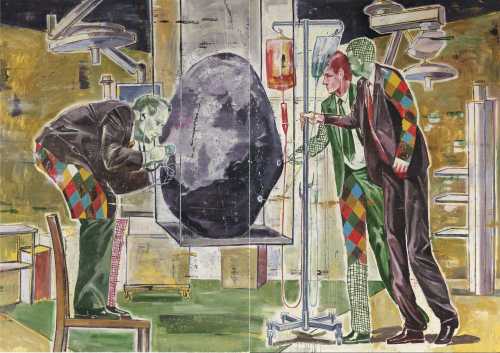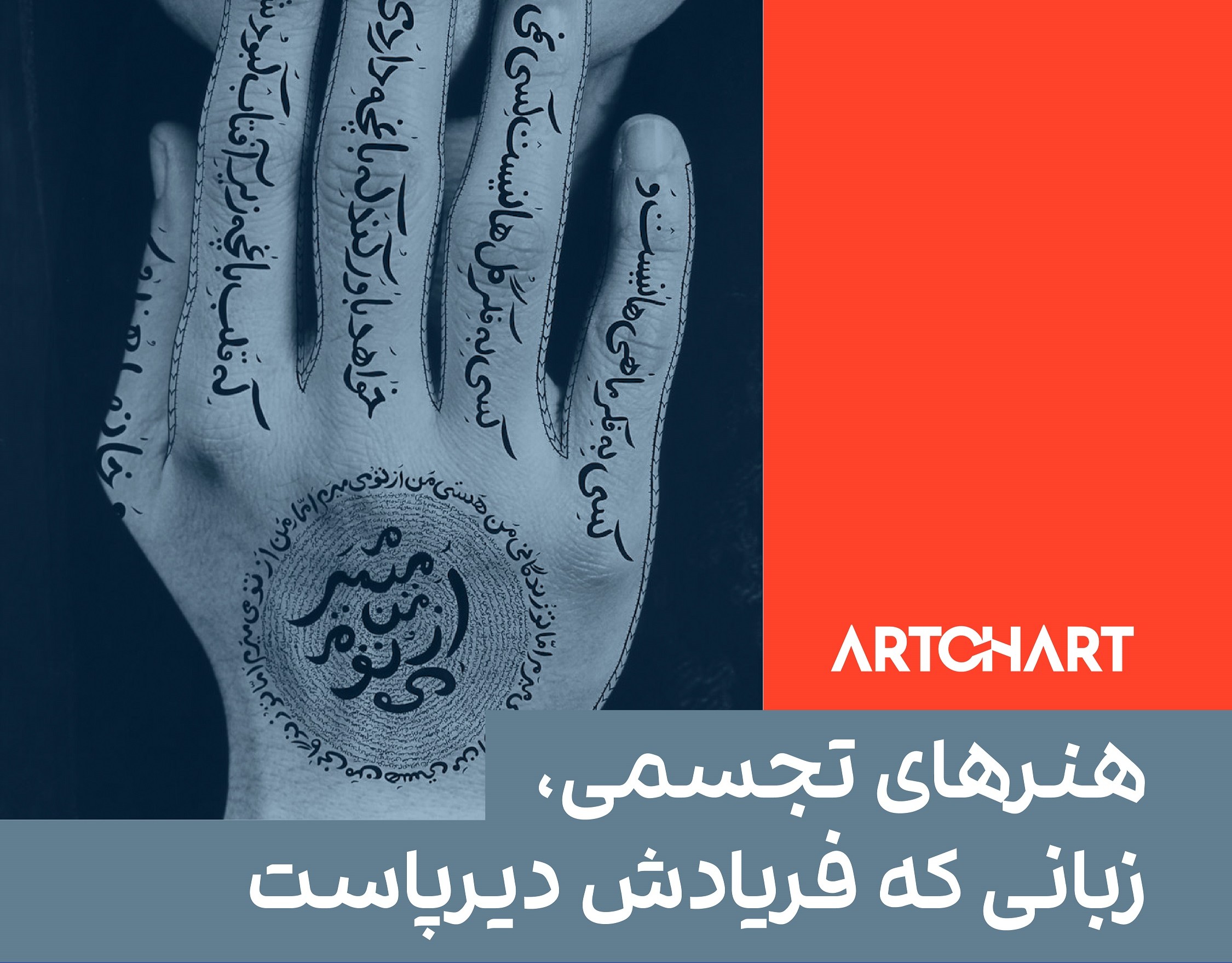About Nikzad Nodjoumi
Nikzad Nodjoumi, a painter, graphic designer and illustrator was born in Kermanshah. Nodjoumi is a committed artist who depicts the stupidity and deception of authorities in his pictorial narratives in an ironic and biting manner. From 1962 to 1967, he received a bachelor's degree in painting from the Faculty of Fine Arts of Iran. A few years later, he moved to the United States to pursue further studies. In 1974, he earned a master's degree in painting from City College of New York. From that time forward, he combined his art with his political and social commitments, working with political groups against the Shah's government in the United States. Consequently, SAVAK prevented him from being hired and teaching at government institutions when he returned to Iran.
His first solo exhibition was held in 1974 at the Seyhoun Gallery in Tehran. After some time, he returned to New York to continue his professional activities. In the days leading up to the revolutionary uprising of 1979, he traveled back to Iran once again. However, his stay in Iran did not last long. He immigrated to the United States in 1981 following an exhibition of his drawings and paintings at the Tehran Museum of Contemporary Art. Nodjoumi has exhibited his works many times individually and as a group inside and outside Iran.
His first solo exhibition was held in 1974 at the Seyhoun Gallery in Tehran. After some time, he returned to New York to continue his professional activities. In the days leading up to the revolutionary uprising of 1979, he traveled back to Iran once again. However, his stay in Iran did not last long. He immigrated to the United States in 1981 following an exhibition of his drawings and paintings at the Tehran Museum of Contemporary Art. Nodjoumi has exhibited his works many times individually and as a group inside and outside Iran.
The focus of Nodjoumi's early career was graphic design and illustration. A number of children's books were illustrated by him during this period for the Institute for the Intellectual Development of Children and Young Adults, including Gol-e-Bolour and Khorshid (1968), which was selected at the Bologna festival. It was in the 1970s that he began to paint social and political themes. The artist aimed to convey that sense of terror and suffocation in his paintings by creating a multi-part space, with intertwined colors and signs scattered across dark and light parts. After that, he studied Iranian painting for a period of time; however, in his own words, "ten or fifteen years of painting in this field led to abstract results." During the 1990s, with a fundamental change in his vision and practice, he began to express his concerns about society and politics through a metaphorical, two-sided, humorous language. A balance has now been established between reality and fantasy in his visual world, between himself and the outside world. Throughout these works, he combines human and animal motifs in grotesque settings. The simultaneous coexistence of these elements in absurd and funny situations attributes a certain level of stupidity to their characters, which represent politicians and powerful people.
The Most Expensive Artwork
At Auctions
First Attendance
24 October 2007
# Attendance
31
# Artworks
38
Average Realized Price
9,992 USD
Average Min Estimate
5,574 USD
Average Max Estimate
9,725 USD
Sell-through Rate
65.517%
Average Growth of Artwork Worth
7.678%
Timeline
Arab, Iranian & Turkish Art / Modern & Contemporary Middle Eastern Art | N°22 auction
15 December
Soft Edge of the Blade Vol. 3 exhibition
10 November
Continuum: The Unbroken Line of Persian Art exhibition
2 November
Modern and Contemporary Middle East auction
1 May
Fragments of Persian Modernity: Selected pieces from Iranian Modern and Contemporary Art exhibition
13 April
Artist’s Emergency Aid Part V exhibition
14 March
Remembrence exhibition
7 March
Modern and Contemporary Collector exhibition
7 February
Middle East / 20th Century Art auction
19 December
The Rhetoric of Objects exhibition
6 December
FINE FOLK OUTSIDER auction
18 November
Timeless Creation exhibition
25 October
Arthibition- November 2024 auction
25 October
A Selection of Works Less than 200 Million Tomans exhibition
19 September
Resize exhibition
16 August
Golden Years exhibition
14 June
Attitude exhibition
31 May
A Collection exhibition
10 May
Connoisseur's Look exhibition
19 April
#6 Master Artists auction
24 March
10s of Artworks, 10s of Millions exhibition
8 March
Art Advisory exhibition
8 March
New Year/ New Vision exhibition
23 February
The Artwork of Legendary Artists exhibition
9 February
#4 auction
4 February
#3 auction
9 January
#2 auction
24 December
Let’s Talk exhibition
9 December
Modern & Contemporary Art of The Middle East, Autumn Harvest auction
2 November
Border exhibition
27 October
Event: Iranian Contemporary Art and Shifting Realities exhibition
20 October
Recovery 04 exhibition
8 September
Antifragile Human exhibition
4 August
Ten days like flower 2 exhibition
21 April
resize exhibition
13 April
As It Unfolds: Property From the Personal Collection of Robin Woodhead auction
10 November
Tails of the Lost Dreams exhibition
10 September
Art Closer Than Ever exhibition
26 August
Benefit 2022 auction
14 June
Vanishing Point exhibition
6 May
A Selection of Modern Works from The Laal Collection exhibition
25 February
Process exhibition
25 February
Opportunity exhibition
13 February
Soft Edge of the Blade exhibition
10 February
now... exhibition
10 September
We The Witnesses exhibition
10 September
Fine Art auction
15 July
8th Collector exhibition
9 July
Twentieth Century Art & Design auction
8 May
Parenthesis/The 1400 series exhibition
5 March
Sanctuary exhibition
15 January
Distribution of the sensible exhibition
30 October
The New York Times Drawings 1996 - 1998 exhibition
27 October
Singing a New Song exhibition
17 October
Doyle at Home auction
29 September
In Support of the Lebanese Red Cross - Artists for Lebanon auction
17 September
Contemporary Collector auction
11 August
One by One exhibition
3 July
Shabtab 7 exhibition
14 February
5th Collector exhibition
24 January
New York Times Sketchbooks exhibition
21 November
Foad Sharifi Print Makings exhibition
12 April
Middle Eastern Art: Then and Now auction
27 March
2018 Collection Selling exhibition
17 January
Please Be Seated exhibition
21 November
American and European Fine Art auction
25 October
Modern and Contemporary Middle Eastern Art auction
24 October
Human Geoghraphy exhibition
28 September
Classical Gas - Online Discovery auction
19 September
Fractures exhibition
12 May
Winter auction
16 February
Shabtab 3 exhibition
31 January
Kalideh exhibition
24 October
Manichean Paintings 1977 | 1978 exhibition
30 September
Alchemy: Objects of Desire auction
21 April
You and Me exhibition
26 January
Contemporary Curated auction
10 June
چهارمین دوره حراج تهران auction
29 May
Contemporary Curated auction
5 March
Modern and Contemporary Arab,Iranian and Turkish Art Part II auction
30 October
Ayyam - Dubai - September 2013 auction
16 September
International Modern and Contemporary Art auction
30 October
Modern and Contemporary Arab and Iranian Art auction
23 October
Modern & Contemporary Arab & Iranian Art auction
24 October
Articles
Visual arts, a durable scream 17 November 2022
At this historical moment, art, like all fields, has faced fundamental questions: What is the mission of the artist in relation to political and social struggles? Or, basically, what is the relationship between art and struggle? When we specifically think about visual arts and consider the specific possibilities and limitations of this field of arts, questions like this take on a mo...

